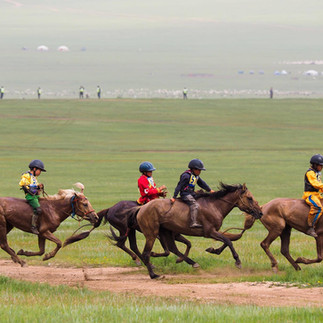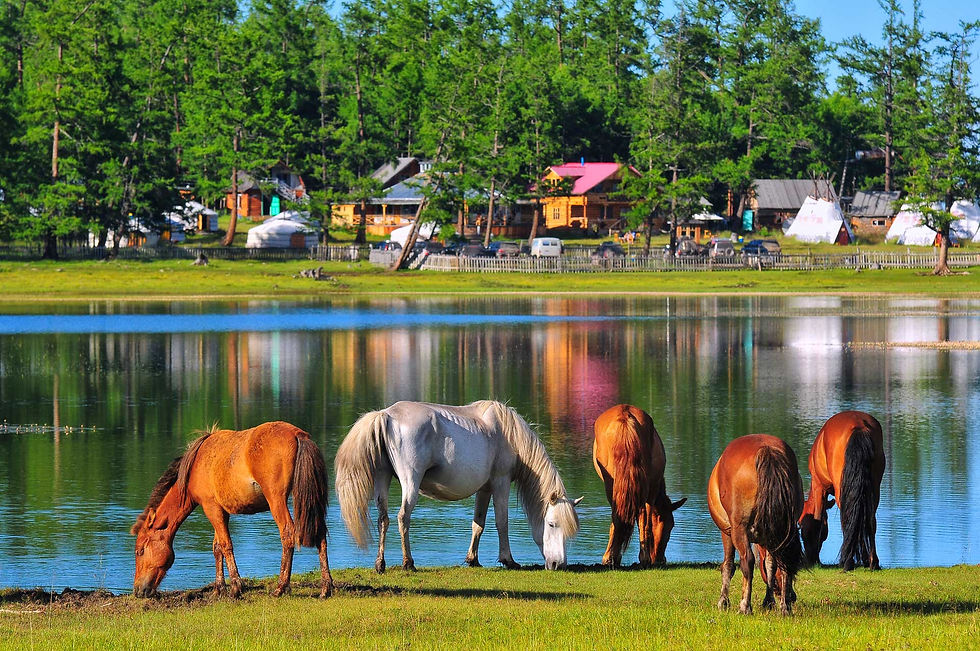About Mongolian horses | Mongolian tour operator
- Enkhzaya Ganbold
- Jun 28, 2022
- 6 min read
Updated: May 29, 2024
What are Mongolian horses?
Fig 1: Mongolian horses
Different strains of Mongolian horses are kept by nomads. Mongolian horses in captivity resemble wild horses in the Takhi. There was always one Azarga, who would lead multiple adult females, called Güüs in English, as well as their offspring. The name of foals depends on their age: foals born this year are called Unaga; as they develop, they become Daaga, Shüdlen, Khyazaalan, Soyolon, and Ikh-nas. A Mongolian horse's build is stocky, with short, strong legs and a large head. Their weight ranges from 500 to 600 pounds. They have an extremely long mane and tail. Their strands are often used to braid ropes, while their tail hair is ideal for violin bows. Mongolian horses are exceptionally strong and can gallop for 10 kilometres without stopping, despite their small size. Mongol horses are capable of pulling a cart pulling 4400 lbs for 50–60 kilometres per day.
Fig 2: Mongolian nomadics
Categories of Mongolian horses
Agt, the sterilized male horse, was the only fundamental difference between captivity and the wild. When a young male approaches sexual maturity, Azarga may chase it out of his natal group. However, nomads in captivity castrate young males between the ages of 3 and 4 to reduce aggression. These Agts are able to remain with their natal group. Nomads ride horses with some of the castrated males.
Fig 3: Young horse racers
Nomadic family and Mongolian horses
Young nomads' fundamental skill is riding horses. The horses they ride have their own names: Mori. Some young boys can ride horses without saddles. Mongolian nomads allow their horses to roam free. Horses graze freely on the grassland, so it was easy for us to observe some of their social behaviours. The horses like to groom and use their teeth to interact with each other. Wild horses also have agonistic relations with neighbouring groups. Azarga, on the other hand, almost always positions himself at the outer edge of the group, constantly moving around to herd the females, keep the group away from neighbouring groups, and chase away bachelors from the outside.
Fig 4: Horse racing and Naadam festival
Mongolian horse racing
One of the "three manly arts" is horse racing. Following traditional wrestling, horse racing is Mongolia's second most popular event. In Mongolia, races can last up to 30 kilometres and involve thousands of horses. Mongolian horses are extraordinarily strong and have great endurance. Despite being faster than Mongolian horses, foreign breeds are usually exhausted at the end of a race, while Mongolian horses still have the wind in their sails. The Naadam race has still been associated with horses dying from exhaustion. Throughout Mongolia, racing is a sport that everyone takes part in. During the fair, each family chooses the best horse in their herd to race. Recent years have seen the sport change due to fast foreign cross-breeds. Breeders can only afford a Thoroughbred/Mongolian mix if they are extremely wealthy, and such horses tend to win races. The result has been complaints that ordinary people no longer have a chance to win, and racing has become the privilege of the elite. Race horses with children in the saddle run in a full gallop over 35 km at a time. The horses are lighter when children are in the saddle. As much as Mongolians care about the jockey's skill and experience, they are more interested in the horse's ability.
Who we are? Enza tours LLC - Mongolian tour operator

Enza Tours LLC is a Mongolian tour operator that specializes in providing high-quality travel experiences to travelers from around the world. As a leading tour operator in Mongolia, Enza Tours has extensive experience and expertise in organizing tours and adventures that showcase the country's unique culture, natural beauty, and rich history.
Enza Tours offers a wide range of tour packages, including cultural tours, adventure tours, horseback riding tours, hiking and trekking tours, and many more. Each tour is carefully crafted to provide travelers with an authentic and unforgettable experience of Mongolia.
With a team of highly trained and experienced tour guides, Enza Tours ensures that every aspect of the tour is well-organized and executed to the highest standards. From transportation to accommodations and activities, every detail is taken care of, allowing travelers to relax and enjoy their trip to the fullest.
As a responsible and sustainable tour operator, Enza Tours is committed to promoting sustainable tourism practices in Mongolia. The company works closely with local communities and partners to ensure that its tours have a positive impact on the environment and the local economy.
In summary, Enza Tours LLC is a premier Mongolian tour operator that offers a wide range of travel experiences to travelers from around the world. With a focus on quality, authenticity, and sustainability, Enza Tours is the ideal choice for anyone looking to explore the wonders of Mongolia.
FAQ on Horse Riding in Mongolia
What is the best time of year for horse riding in Mongolia?
The ideal time for horse riding in Mongolia is from June to September. During these months, the weather is warm, and the landscapes are lush and green. Additionally, July features the Naadam Festival, where you can witness traditional Mongolian sports, including horse racing.
Do I need prior horse riding experience to join a tour in Mongolia?
No prior experience is necessary. Many tours cater to all skill levels, from beginners to advanced riders. Tour operators provide well-trained horses and experienced guides to ensure your safety and comfort.
What should I pack for a horse riding trip in Mongolia?
Essentials for your trip include:
Layered clothing for varying temperatures
A good quality riding helmet and sturdy riding boots
A waterproof jacket
Sunscreen, a hat, and sunglasses
Comfortable, breathable clothing
A first-aid kit and personal medications
A reusable water bottle
How long do horse riding tours typically last?
Horse riding tours can vary from short day trips to extensive expeditions lasting up to two weeks. Popular options include 8-day, 12-day, and 14-day tours.
What type of accommodation can I expect on a horse riding tour?
Accommodation often includes staying in traditional gers (yurts), which provides a unique cultural experience. Some tours may also offer camping options or stays in basic lodges.
Is it safe to drink water in Mongolia?
It's recommended to drink bottled or boiled water. Tour operators typically provide bottled water, but bringing a reusable water bottle with a filter or purification tablets is wise.
What wildlife might I encounter while horse riding in Mongolia?
You may encounter:
Argali sheep and ibex in the mountains
Various bird species, including golden eagles
Wild horses (Przewalski's horses)
The elusive snow leopard in the Altai Mountains (rare sightings)
How can I be respectful towards the local nomadic culture?
To show respect:
Ask for permission before taking photos
Accept food or drink offered by hosts
Avoid stepping on or pointing feet towards the hearth inside a ger
Offer small gifts like sweets or tea
Learn a few basic phrases in Mongolian
What kind of food will be available during the tour?
Expect traditional Mongolian dishes like:
Buuz (steamed dumplings)
Khuushuur (fried dumplings)
Tsuivan (stir-fried noodles with meat)
Various dairy products such as airag and dried curds Tour operators usually provide a mix of traditional and familiar foods.
Are there any health concerns or vaccinations needed before traveling to Mongolia?
Consult with a healthcare provider for recommended vaccinations such as:
Hepatitis A and B
Typhoid
Tetanus-diphtheria
Rabies (for extensive outdoor activities) Carry a basic first-aid kit and personal medications.
Can I customize my horse riding tour?
Yes, many tour operators offer customizable tours to suit your preferences. Discuss with the operator the duration, routes, and specific experiences you want to include.
What should I expect from the terrain and riding conditions?
Mongolia's terrain is diverse, including:
Easy and flat steppes and plains
Challenging mountainous areas with uneven paths
Sandy and difficult terrain in the Gobi Desert Expect a mix of different terrains on most tours for a comprehensive riding experience.












































